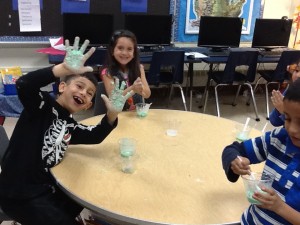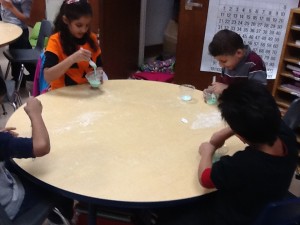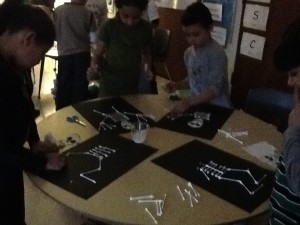I can demonstrate application of telling and writing time by modeling 10 “times” on the hour given on an analog clock2.MD.7 No School I can demonstrate application of telling and writing time by modeling 10 “times” on the half hour given on an analog clock2.MD.7 I can demonstrate application of telling and writing time by modeling 10 “times” on the quarter hour given on an analog clock2.MD.7 I can demonstrate synthesis of drawing a graph by creating tallies and a graph of the student information gathered in the “hand washing” survey.
I will write 10 “times” that are modeled for me on an analog clock in my journal. I will write 10 “times” that are modeled for me on an analog clock. I will write 10 “times” that are modeled for me on an analog clock. I will read the results of the germ surveys and tally the results.
Science
I can demonstrate application of the scientific process by developing one question to begin our research on germs. SIP.02.11 NO School I can demonstrate analysis of collecting information for problem solving by examining the role that germs play in our lives and finding 2 ways they affect us. SIP.02.12 I can demonstrate application of planning simple investigations by developing 3 questions for our school survey about hand washing. SIP.02,13 I can demonstrate application of planning and conducting investigations by carrying out a survey to 2nd-5th grade students about hand washing.
I will write one question to begin our research on germs. I will write 2 ways that germs affect me. I will write 3 questions for our school survey about hand washing. I will read the results of the surveys and tally the results.
Social Studies
I can demonstrate application of community projects by applying what we learned about germs to informing others in 2 different ways. C5.0.1.0.3 I can demonstrate synthesis of community projects by creating 3 questions for our school survey about hand washing. C5.0.1.0.3 I can demonstrate synthesis of community projects by proposing the next step to take in our community project.
C5.0.1.0.3
I can write 2 ways to inform others of our findings. I will write 3 questions for our school survey about hand washing. I will write my idea for the next step in the community project on germs and hand washing.
Writing
I can demonstrate knowledge of writing an opinion piece by stating what an opinion is and stating my opinion about 2 topics. No School I can demonstrate knowledge of writing an opinion piece by stating my opinion on “Why do we get sick?” I can demonstrate comprehension of writing an opinion piece by giving at least one example to explain my opinion. I can demonstrate application of drafting by continuing and elaborating my writing. 2.nbt.4
Reading
I can demonstrate reading on level texts by choosing 2 books that are a good fit for my reading ability. . RF.2.4 A NO school I can demonstrate knowledge of dictionaries by locating 5 words and definitions in a dictionary. L2.2 I can demonstrate knowledge of thesauri by locating 5 words and synonyms in a thesaurus. L2.2 I can demonstrate knowledge of glossaries by defining 5 specific vocabulary words using the glossary. L2.2
I can read good fit books and discuss what makes them a good fit for me. I can write 5 words and definitions in my journal. I can write 5 words and synonyms in my journal. I can write 5 words and definitions in my journal.




